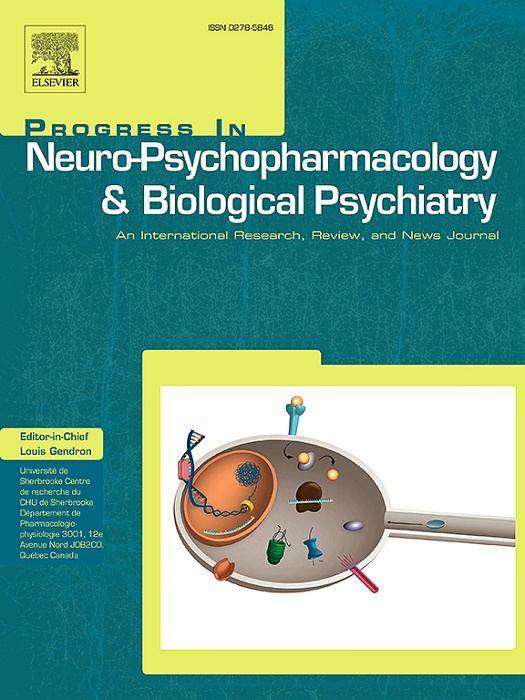使用Florzolotau (18F) PET开发和验证阿尔茨海默病的整体tau严重程度评分
IF 5.3
2区 医学
Q1 CLINICAL NEUROLOGY
Progress in Neuro-Psychopharmacology & Biological Psychiatry
Pub Date : 2025-03-25
DOI:10.1016/j.pnpbp.2025.111343
引用次数: 0
摘要
tau特异性正电子发射断层扫描(tau- pet)对于评估阿尔茨海默病(AD)的严重程度是有价值的,年轻发病的AD (YOAD)和晚发性AD (LOAD)之间的表型差异可能是由tau病理和认知之间的独特关系驱动的。目的本研究采用Florzolotau (18F) PET建立了全球tau严重程度(gTS)量表,并将其与CenTauR评分进行比较,用于标准化tau负担量化。方法共纳入186名参与者,包括一个试验组(15名认知未受损对照组[CTL], 15名AD患者)和一个验证组(27名CTL, 67名YOAD和62名LOAD患者)。在验证组中,使用gTS或CenTauR评分计算诊断YOAD和LOAD的截止值。结果确定白质区是Florzolotau (18F)最合适的参考区。如曲线下面积(AUC)所示,AD和YOAD的gTS截止值均为24.1,LOAD的gTS截止值为34.1,显示出最高的诊断准确性。gTS评分显示,与CenTauR相比,YOAD与CTL或LOAD与CTL的AUC更高。gTS分数显著预测认知能力筛查工具的总分和子域。认知-gTS曲线特征分别与YOAD和LOAD呈二次和线性关系,说明gTS得分与认知之间存在不同的关系。结论来自Florzolotau (18F) PET扫描的gTS评分,对tau负担和认知测量提供了重要的预测。与CenTauR通用评分相比,gTS的AUC更高,这表明gTS评分为区分AD和CTL提供了一种可靠的方法。本文章由计算机程序翻译,如有差异,请以英文原文为准。
Development and validation of global tau severity score in Alzheimer's disease using Florzolotau (18F) PET
Background
Tau-specific positron emission tomography (tau-PET) is valuable for assessing Alzheimer's disease (AD) severity, with phenotypic differences between young-onset AD (YOAD) and late-onset AD (LOAD) likely driven by distinct relationships between tau pathology and cognition.
Objective
This study developed a global tau severity (gTS) scale using Florzolotau (18F) PET and compared it with the CenTauR score for standardizing tau burden quantification.
Methods
A total of 186 participants were enrolled, including a pilot group (15 cognitive unimpaired controls [CTL], 15 AD patients) and a validation group (27 CTL, 67 YOAD, and 62 LOAD patients). In the validation group, cutoffs for diagnosing YOAD and LOAD using the gTS or CenTauR score were calculated.
Results
The white matter region was identified as the most suitable reference for Florzolotau (18F). The gTS cutoff values of 24.1 for both AD and YOAD and 34.1 for LOAD demonstrated the highest diagnostic accuracy, as indicated by the area under the curve (AUC). The gTS score showed a higher AUC compared to CenTauR in YOAD versus CTL or LOAD versus CTL. The gTS scores significantly predicted total scores and subdomains on cognitive ability screening instruments. Cognitive-gTS curve features were found to have quadratic and linear relationships with YOAD and LOAD, respectively, illustrating different relationships between gTS scores and cognition.
Conclusion
The gTS score, derived from Florzolotau (18F) PET scans, provides significant predictions regarding tau burden and cognitive measurements. The higher AUC of gTS compared to the CenTauR universal scores indicates that gTS scores offer a robust method for differentiating AD from CTL.
求助全文
通过发布文献求助,成功后即可免费获取论文全文。
去求助
来源期刊
CiteScore
12.00
自引率
1.80%
发文量
153
审稿时长
56 days
期刊介绍:
Progress in Neuro-Psychopharmacology & Biological Psychiatry is an international and multidisciplinary journal which aims to ensure the rapid publication of authoritative reviews and research papers dealing with experimental and clinical aspects of neuro-psychopharmacology and biological psychiatry. Issues of the journal are regularly devoted wholly in or in part to a topical subject.
Progress in Neuro-Psychopharmacology & Biological Psychiatry does not publish work on the actions of biological extracts unless the pharmacological active molecular substrate and/or specific receptor binding properties of the extract compounds are elucidated.

 求助内容:
求助内容: 应助结果提醒方式:
应助结果提醒方式:


